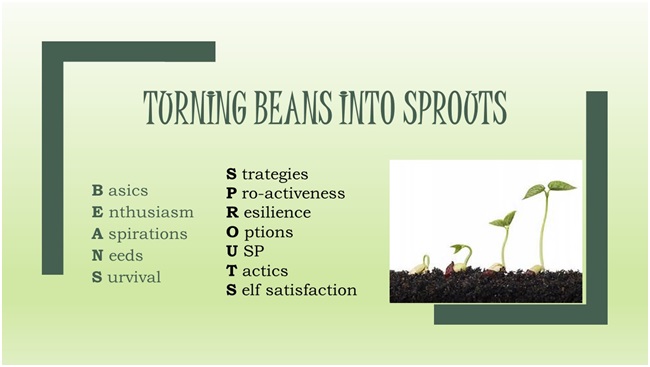A Coaching Model Created by Lai Kean Lee
(Career Coach, SINGAPORE)

Every human being has “beans” in their lives.
Rather than struggling through these elements, my coaching approach is to empower an individual to nurture “sprouts” out of these elements by :
As a coach, my objective is to help people improve their performances and enhance the quality of their lives, to help people produce fulfilling results in their personal and professional lives. This is achieved by supporting the client and helping the client to establish what is important to them. This may, very well, be their aspirations and their value systems.
While I advocate that every human being has “BEANS”, it is more likely that people are aware of others :
With all these “awareness”, yet one often find themselves knowing the least about themselves :
Hence, one of the important tasks of a coach is to create awareness so as to help the client recognise what he or she wants.
The need to create awareness encompasses critical skills of a coach to exercise “active listening” and “powerful questioning”. In order to achieve these effectively, I need to gain the trust of my client, to create an environment of trust where my client is free to talk about their dreams, their hopes and their aspirations with total confidence.
What are my clients’ own personal values, goals or vision ? Here, my coaching application should take the client to a deeper level and help them to really clarify what they want out of life. Again, the skill of “powerful questioning” is essential in helping the client achieve deeper self-awareness. I would also exercise “reframing” to move a client from a disempowering perspective to an empowering perspective. It is important for the client to understand their own strengths and their own values and in turn, they may be in a better position to identify their own USPs.
Taking action or being in action is another important element in coaching. If I want the client to feel successful and achieving results, action needs to be taken. Nothing will happen if there is no action. However, often we find ourselves afraid to take that first step because of :
As a coach, I cannot take actions for my clients but I can encourage and lead them into wanting to take actions. A possible action that the client comes up with for himself or herself will the one that he or she is most likely to follow through.
Some clients may already have an action plan in mind and hence, what the client would like most to do is to have me listen out their plan, help them clarify and even raise questions to spark further ideas for enhancement.
The more challenging scenario may be one where clients do not generate their own action plans or have a tendency to rely on the coach for ideas. In such cases, I will deploy questioning techniques to encourage movement or to invite the client to take action. By giving the client the space and asking the right questions, they will come up with their own ideas. Whether the client wants to take actions or not, ultimately, the client makes that choice.
Very often, when action plans are in place, the client does not have commitment to carry out or follow through the action. So, as a coach, I will clarify what is the action required and when is this action to take place. By simply asking the appropriate questions, I am laying down some specifics for my clients to move forward. However, care needs to be exercised not to push the client into committing something that they don’t really want to do. Ultimately, the client has to take responsibility and assume accountability for their own actions.
While I also advocate that life is full of options, there are instances when clients are not willing to act and/or commit. Many would say to “think out of the box” but a person may be held back from moving forward due to some underlying beliefs that they hang on to. It is critical for me, as a coach, to empower the client face up to their own underlying beliefs.
Another technique that can be deployed is to reframe perspectives – helping the client to see things differently and see new possibilities, find new ways to meet challenges.
The ultimate end result of the client is for him or her to realise his or her goals. One of the ways would be to invite the client to visualise the end result of what they want from their goals. This helps the client to maintain their hope of achieving their goals, making it more real. As the picture of that goal achievement is being formed in the mind, the client is able to see the path towards it.
What’s more satisfying for the client than achieving what he or she has set out to do and that is working towards self-satisfaction. Through visualization, the impossible now seems possible.